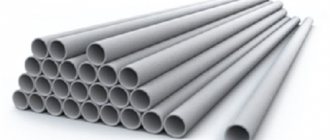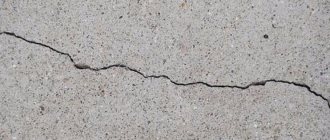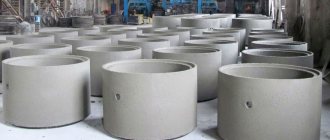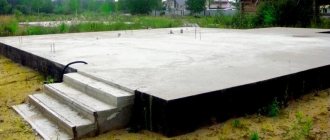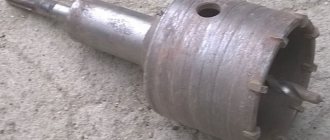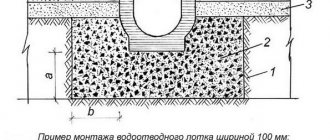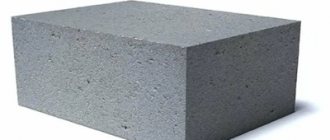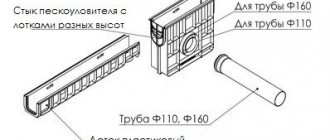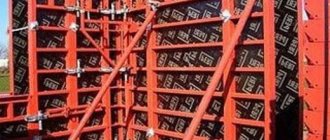Most often, reliable metal or polymer materials are used in the manufacture of pipelines. Instead, when performing road and construction work, reinforced concrete pipes are used, which have rigidity and the ability to withstand heavy loads.
When performing road and construction work, reinforced concrete pipes are used, which have rigidity and the ability to withstand heavy loads.
Types of concrete pipes
Reinforced concrete pipe (RC pipe) is a special product for laying communications, which is made from heavy-duty grades of concrete. When joined together, a pipeline is created, the tightness of which is ensured using sealants, bituminous hemp, and rubber O-rings.
Reinforced concrete pipe links
There are different types of pipes. So, according to their shape they are divided into square and round, according to their diameter - into small (50-110 cm) and large (110-550 cm). According to the method of joining together, products are classified into seam and socket. In addition, the pipes differ from each other in length and included materials.
Pressure
Pressure pipes transport liquids under pressure created by pumping stations. Typically these are pipelines of water supply and sewerage systems with high throughput.
Some products can withstand only low pressure (up to 10 atm) and are called low-pressure. Medium-pressure structures tolerate up to 20 atm, high-pressure structures - up to 25 atm.
For their production, cement grade M400 and higher is used. Cores for pressure pipes can be made of steel or polymers. They do not deteriorate even from the distillation of aggressive liquids at temperatures up to +400 degrees.
Gravity
Through such pipes, liquids flow independently, without pressure, mainly due to the slope, which is laid immediately during the construction of the route. This group includes pipelines for domestic and storm sewerage, and systems for groundwater. They are made from ordinary and quick-hardening Portland cement, Portland slag cement, concrete with the addition of sulfate-resistant and corrosion-resistant components.
Important! Gravity pipes cannot withstand heavy loads.
Gravity pipes for storm drainage
TB type
The table defines the norms for loading reinforced concrete pipes in the event that a standard truck with a carrying capacity of 18 to 20 tons is used, as well as the railway loading norms for 1 gondola car approved by Russian Railways OJSC.
TB type pipes are supplied together with sealing rings made of rubber. The use of these rings helps to significantly reduce the time period required for installation of the structure, and also completely eliminates additional financial costs that could arise if it is necessary to use additional materials.
It should also be noted that such rings significantly increase the tightness of the pipes. The installation of the rings is carried out as follows: the rings are mounted on the sleeve end of the pipe, as a result of which, when the pipe section is subsequently joined, the ring is pinched, which in turn guarantees maximum tightness of the pipeline.
Reinforced concrete pipes of this type represent the standard of reinforced concrete products, because:
- During their manufacture, all successive stages of production work are strictly observed.
- In the manufacturing process of these structures, granite crushed stone is used, which is considered the highest quality raw material.
- The installation process is as easy and quick as possible, since only during the manufacture of these pipes is the grinding of the inside of the socket, in conjunction with the ideal geometry of the socket joint, carried out.
- The strength characteristics established by GOST 6482-88 even exceed the standards.
- These pipes are characterized by high production capacity.
- Such pipes are supplied together with sealing rings.
- All manufactured products have the necessary certificates.
Reinforced concrete socket pipes are usually divided into 3 main groups: free-flow, pressure, and pipes used in road construction. Gravity pipes are used mainly to lay underground pipelines, the main purpose of which is to transport by gravity various household liquids and other wastewater, as well as liquids used for industrial purposes and not aggressive to reinforced concrete materials.
These pipes are used in various fields. Thus, they are usually used in the process of installing storm drains during the construction of new areas of the city; these pipes are also used in the construction of spillways and drains in areas where various technology parks, logistics centers and industrial enterprises are located. The fundamental advantages of such pipes include their low cost (compared to analogues), high strength characteristics and the absence of problems during installation work.
Manufacturing process (video)
Gravity pipes are also distinguished by their short delivery time, as well as a wide range of products.
It is worth noting that the most popular are reinforced concrete socket pipes of the TB type, and in particular the TB 100.50-3 pipe, the parameters of which are determined as follows: length - 5.0 m, diameter - 1000 mm, wall thickness - 75 mm. The presented type of reinforced concrete pipes has the most suitable loading rate, namely 5 pieces in one vehicle; sometimes it is possible to transport even 6 pieces in one vehicle, which has an even stronger effect on increasing the competitiveness of the price of this design. For example, ordinary reinforced concrete pipes T100.50-2 or pipes T100.50-3 are standardly transported in no more than 2 pieces in one vehicle. Reinforced concrete pipes of large diameters, for example, these include TB 120.50-3 pipes, TB 140.50-3 pipes, TB 160.50-3 culvert pipes, are also transported in no more than two pieces in one vehicle.
In terms of cost, reinforced concrete pipes also remain leaders among other materials, since their price is significantly lower than that of others for many years. This price difference becomes noticeable when comparing the cost of large-diameter pipes from 600 mm and above. In this regard, reinforced concrete material is recognized as the most used in construction. And given the fact that many enterprises today specialize in the production of reinforced concrete products, we can say with confidence that the price of reinforced concrete products will never be overpriced.
Standard pipes made from reinforced concrete are designed to withstand heavy loads throughout their service life, which is 50 years or more. And the depth of laying these pipes depends, first of all, on the degree of reinforcement. The depth indicator can reach up to 6 m from the top of the pipe. Those reinforced concrete pipes that belong to group 2 according to the degree of load can be allowed for use at a depth of 4 m, and pipes belonging to group 3 up to 6 m from the top of the pipe.
The combination of concrete and rigid reinforcement allows these pipes to act as a strong and reliable structure. It is also worth noting that reinforced concrete pipes are not prone to deformation and are able to maintain the structural strength of the culvert structure for as long as possible. That is why, in most cases, design institutes choose reinforced concrete pipes as a material for the construction of spillways and overflows.
Ease of installation of reinforced concrete pipes. Pipes of this type should be laid in an open manner. Technologies for the production of reinforced concrete socket pipes used today make it possible to produce products that meet all the requirements of the modern market. Thus, reinforced concrete pipes are not subject to deformation during transportation, have an ideal geometry of socket joints, and are as comfortable as possible during the installation process. Today, many manufacturers offer to purchase products complete with sealing rings made of rubber.
The use of these rings helps to significantly reduce the time period required for installation of the structure, and also completely eliminates additional financial costs that could arise if it is necessary to use additional materials. It should also be noted that these rings help to significantly increase the tightness of the pipes.
laying pipe type TB
Delivery of reinforced concrete pipes is carried out in the shortest possible time, since they can be transported by both road and railway transport. It is worth noting that the production of reinforced concrete pipes has been established in almost all regions of Russia, which also makes it possible to supply pipes as quickly as possible. This scale of production is due to all the advantages that are characteristic of reinforced concrete pipes, since the demand for them is constantly growing.
As for the product range, today there are several fundamental methods used in the production of socket pipes. Thus, previously it was customary to produce these pipes using the centrifugation method, but now all factories for the production of reinforced concrete products strive to use the vibrocompression method. This technology allows you to produce the maximum volume of products in 1 shift, while maintaining high quality indicators.
Installation and installation of prefabricated pipe sections
To remain competitive, all enterprises producing reinforced concrete products strive to constantly introduce new technologies and developments into the production process. Today, all concrete pipes must be produced according to the requirements established by GOST 6482-88. According to these requirements, the diameter of the culvert opening must be a minimum of 300 mm, a maximum of 2,000 mm. As for the length of the structure, based on the equipment available at the enterprise, this figure should vary from 2.5 meters to 6.0 m.
* The radial press is a modern type of equipment characterized by high productivity and designed to produce concrete pipes with an internal diameter ranging from 300 mm to 1,200 mm and a length of 2.5 m.
This method of manufacturing pipes makes it possible to produce a large volume of products of appropriate quality, and in the shortest possible time. It is also worth noting that the production capacity of the enterprise, acting as a manufacturer, is able to satisfy the needs of any construction project.
According to their load-bearing capacity, concrete free-flow pipes can be divided into 3 strength groups:
- 1 - structures that can withstand loads if the soil is filled up to 2 m to its top point;
- 2 - structures that can withstand loads if the soil is filled up to 4 m to its top point;
- 3 - structures that can withstand loads if the soil is filled up to 6 m from its top point;
To achieve an increase in the load-bearing capacity of pipes, it is necessary to change their reinforcement, while leaving the dimensions unchanged.
According to established standards, the marking of reinforced concrete pipes must include both letters and numbers that determine the type of structure, for example TB 100.50-3. The marking of the pipe TB 100.50-3 is deciphered as follows:
- TV - type of bell
- 100 - passage diameter, measured in cm
- 50 - useful length of the product, measured in dm
- 3 - the number of its strength group
Production of concrete pipes
Moisture-resistant and bioresistant grades of concrete are used to produce products. The main production method is vibrocompression with reinforcement with B1 and BP1 rods, or without reinforcement. The average time to create a pipe is only 3-12 minutes, depending on the specific type of equipment.
The production process consists of the following stages:
- cleaning and lubricating the mold;
- installation of iron rods on the bottom in the form of a frame;
- fixing rods;
- moving the structure into a centrifuge;
- slow supply of solution, filling all voids;
- steaming in a special chamber to gain strength;
- disassembling the mold;
- transportation of the finished pipe to the warehouse.
Key performance characteristics
The main parameter of the pipe is its strength, because the risk of deformation when laying in a ditch and the possible depth of installation depend on it. If the strength is reduced, the pipeline will not bear the load and will not perform its original functions.
The crack resistance of concrete must also be taken into account. Normally, the product can withstand the pressure for which it is designed, and chips of no more than 0.2 mm occur.
GOST 6482-88
Manufacturing standards are regulated by GOST: reinforced concrete pipes according to it must meet water resistance characteristics, in addition, they must undergo internal hydrostatic pressure within 0.05 MPa. Concrete must be frost resistant. In addition, the pipes must be based on heavy concrete, prepared in accordance with GOST 26633, its compressive strength must be equal to B25.
The mentioned compressive strength can be changed, but deviations that go beyond the scope of GOST 13015.0 are unacceptable. The water resistance of the pipe walls must correspond to class W4. Water absorption should not exceed 6% by weight. Steel A-I and A-III (GOST 5781) can be used as a reinforcement frame.
Construction of concrete pipes
Previously, concrete pipes were equipped with bends and very massive walls. Modern products are thinner, while more durable and high-quality raw materials are used for their production.
For weak soils, pipes with a common foundation are produced, and this reduces the amount of pressure. In some cases, a reverse vault is prepared for the foundation, which increases the operating efficiency of the pipeline, ensures the outflow of water, and serves as a tray for leakage.
When installed on roads of low technical category, pipes with a round base of links with a diameter of 1-1.25 m with a wall thickness of 14-16 cm and an additional flat base are used. The latter device contains a welded mesh of reinforcing bars 1 cm thick made of A2 class metal. Typically, such pipes are installed under embankments up to 7 m high, so their installation is considered far from economical.
Advantages
An example of the use of pipes for a septic tank.
Reinforced concrete pipe has a number of advantages:
- does not collapse under the aggressive influence of the external environment; there is no risk of corrosion/rotting (concrete is not subject to such destruction); resistance to sudden temperature changes (low/high); long period of operation (the structure will last about 70 years); ease of use/installation; installation requires a small amount of time; low cost (due to the cost of the material); the internal surface remains smooth (hence the high throughput); minimal metal consumption; less exposed to stray currents; stability/durability; suitable for locations in harsh climates; dielectric parameters .
Return to contents
Various connection methods
Depending on the type of connection, reinforced concrete pipes are:
- Bell-shaped They are used more often than others because they connect easily and quickly. The narrow end of one product is inserted into the extension of the other, and a sealant is placed in the joint area.
- Folded. The joining is carried out due to the quarters selected on the edges - recesses that fit perfectly to the protrusions on the other pipe. From above, the joint is covered with concrete. It will take more time to install such a pipeline, but the cross-section will be perfectly smooth.
Projects
POLICY OF UNICON-ZSK LLC IN THE AREA
PROCESSING AND SUPPORT
SECURITY OF PERSONAL DATA
1. GENERAL
PROVISIONS
In order to ensure compliance with the provisions of the Federal Law of July 27, 2006 No. 152-FZ “On Personal Data,” UNICON-ZSK LLC (hereinafter referred to as the Company) considers the most important task to ensure the legitimacy of the processing and security of personal data (hereinafter – PD) subjects in business processes.
To solve this problem, the Company has introduced, operates and undergoes periodic review (monitoring) of a personal data protection system.
The processing of personal data is based on the following principles:
— the legality of the purposes and methods of processing personal data and their integrity;
— compliance of the purposes of processing personal data with the goals predetermined and stated when collecting personal data, as well as with the powers of the Company;
— compliance of the volume and nature of the personal data processed, methods of processing personal data for the purposes of processing personal data;
— the reliability of personal data, their relevance and sufficiency for the purposes of processing, the inadmissibility of processing personal data that is excessive in relation to the purposes of collecting personal data;
— the legitimacy of organizational and technical measures to ensure the security of personal data;
— continuity of increasing the level of knowledge of employees in the field of ensuring the security of personal data during their processing;
— striving for continuous improvement of the personal data protection system.
2. LEGAL BASIS AND PURPOSE OF PROCESSING PERSONAL DATA
In accordance with the principles of processing personal data, the Company has determined the composition and purposes of processing personal data:
— reviewing resumes (including obtaining additional information) and selecting candidates for employment for a vacant position in the Company;
— checking the integrity of candidates for employment for a vacant position before hiring to the Company;
— conclusion, support, amendment, termination of employment contracts, which are the basis for the emergence or termination of labor relations between the employee and the Company, and fulfillment of obligations stipulated by administrative documents, local regulations and employment contracts;
— registration of compulsory and voluntary medical insurance policies for employees and assistance in resolving controversial situations in the event of insured events;
— organization of access and intra-facility regime on the territory of the Company;
— registration and representation of powers to provide the interests of the Company to employees and other persons;
— conclusion of changes, termination of civil law contracts, which are the basis for the emergence, change or termination of relations with the Company, and fulfillment of obligations stipulated by civil law contracts;
— checking the integrity of counterparties and checking the powers of persons signing civil contracts;
— interaction with contact persons of counterparties in the process of concluding, maintaining, changing, terminating civil contracts, which are the basis for the emergence, change or termination of relations with the Company;
— fulfillment of obligations provided for by the current legislation of the Russian Federation.
3. RULES FOR PROCESSING PERSONAL DATA
note
The Company processes only those personal data that are presented in the approved List of Personal Data.
The Company processes the following categories of personal data subjects:
— candidates for employment for a vacant position;
— employees;
— close relatives of candidates for employment for vacant positions and employees;
— third parties (individuals and legal entities) for registration and issuance of powers of attorney on behalf of the Company;
— performers and other persons who are parties to civil contracts (individuals, individual entrepreneurs);
— visitors to the Company’s territories;
— heads of organizations - counterparties under civil contracts;
— other persons performing actions and having other relationships with the Company.
The Company does not allow the processing of categories of personal data relating to race, nationality, political views, philosophical, religious beliefs, intimate life, as well as criminal record information.
Processing of personal data relating to the health status of the Company's employees is permitted only in cases provided for by labor legislation, including legislation on labor protection, legislation on social protection of disabled people, as well as in other cases with the written consent of employees for such processing. Processing of data relating to the health status of the Company's employees is carried out without the use of automation tools. The Company does not process personal data relating to the health status of other categories of personal data subjects.
The Company processes biometric personal data (information that characterizes the physiological and biological characteristics of a person, on the basis of which one can establish his identity) - photographs of the Company’s employees in order to organize proper access and intra-facility regime, create and operate websites, and the Company’s corporate portal. The processing of the specified biometric personal data is carried out solely on the basis of the consent of the subjects received in writing.
The Company carries out cross-border transfer of personal data (transfer of personal data to the territory of a foreign state to an authority of a foreign state, a foreign individual or a foreign legal entity).
Markings and sizes
All concrete pipes are marked according to their functional purpose. The marking consists of letters and numbers and is applied to the end of the product. Main types of pipes:
- T - cylindrical in the shape of a cone with a sleeve, have an o-ring;
- TN – for pressure systems with pumps;
- TP - pipes similar to T, but with sockets;
- TB – with a thrust collar and rubber rings;
- TBP – with sole;
- TS – with a stepped surface and seals;
- TSP – with reinforced concrete sole;
- TFP – folded with seals;
- TBFP – seam with sole;
- TO - like the previous ones, only with oval holes;
- TE – with ellipsoidal holes.
Also, the marking of concrete products must contain numbers. The first of them reflects the internal cross-section, the second – the length in decimeters, the third – the load-bearing capacity.
Some manufacturers additionally add a letter to reflect the permeability of the walls and resistance to various substances. For example, the letter “O” denotes particularly low permeability, “P” - reduced, “N” - normal, “Sh” - resistance to alkalis, “K” - resistance to acids.
Design features
The peculiarity of such products is that their configuration can be supplemented with some elements or completely dispensed with (depending on the type and purpose of use).
For example, reinforced concrete culvert pipes use an additional element such as a rubber sealing ring. It provides high sealing (thus, liquid will not escape from the pipes). List of possible components:
- pattern block; weighting material; geofabric.
This or that additional tool increases some positive parameters of pipes, speeds up work, makes it easier, makes structures stronger and more stable.
The quality parameters and characteristics of products are regulated by GOST. It also contains a section on additional components. In any case, before using additional materials yourself, you should consult with the seller and determine:
- compatibility of parts; method and scope of use; permissible parameters; service life.
Return to contents
Scope of application of concrete pipelines
Most often, such systems are used to create pipelines buried 5-10 meters that carry liquids of varying degrees of aggressiveness.
The main directions of their operation:
- sewerage for household and industrial waste;
- main type collectors;
- storm sewers, systems for drainage of melt and sediment waters;
- pipelines for pumping non-aggressive liquids;
- drainage through road embankments;
- reclamation systems;
- drainage systems;
- devices for “locking” underground rivers;
- sewers under railway tracks;
- pipelines under bridges and buildings;
- concrete microtunnels for placing cable networks and other communications;
- systems for transporting liquid chemicals.
Advantages and disadvantages
The main advantage is the durability of reinforced concrete products. Thus, the service life of most of them is 50-100 years, since the base material is resistant to adverse factors.
Other advantages of pipes are:
- slight susceptibility of metal elements to corrosion;
- possibility of operation in an aggressive environment;
- excellent resistance to physical impact;
- impermeability to liquids (moisture resistance W4-W6);
- resistance to biological damage, overgrowth, rotting, temperature changes, inertness to the action of many chemical reagents;
- highest strength, resistance to fracture, cracking, bending and deformation (more effective compared to polymers);
- frost resistance from F50 to F300;
- non-flammable, no risk of melting when heated;
- no damage due to stray currents;
- economical production, short production process;
- availability of a wide range of products with various technical parameters;
- ease of installation, precision joining of individual elements;
- reducing the labor intensity of sealing due to rubber seals included in the kit.
The disadvantage of the products is their significant mass, although due to their weight they successfully resist the buoyancy forces that inevitably affect the walls during floods, thaws, and soil heaving.
On a note! Under certain conditions, the fittings inside the pipes can still be subject to corrosion, as a result of which build-up forms or the walls become thinner.
Portal walls
Dimensional reinforced concrete slab with a round hole. Thanks to the portal walls with characteristic curved edges, the slab is properly fixed in the soil of the embankment. Also, the edges of these walls make it possible to strengthen the edges of the embankment, since they prevent the collapse of the soil. The basis of the pipe is round-shaped links with water-carrying capacity, and the portal wall acts as a reinforcement for the head.
This design is recognized as universal, so they are used everywhere, even in the Far North. The main purpose of these pipes is the trouble-free passage of melt and storm water flows containing various particles. Under embankments of highways and railways and under small bridges in areas where plains predominate, pipes of exclusively round shape are also used. Often, the embankment has a height of 20 m or more, for this reason the portal walls must withstand strong pressure from the soil, coupled with various vibrations and vibrations from the constant movement of traffic.
Application:
Comparing the characteristics of prefabricated reinforced concrete with a monolith, it immediately becomes clear how much more expedient it is to use reinforced concrete. In addition to the fact that it is more profitable from an economic point of view, the reliability of reinforced concrete walls, coupled with speed and ease of installation, allows this structure to remain a leader on the market for more than 30 years. It is also worth noting that in the process of obtaining a quality certificate, reinforced concrete portal walls are necessarily tested for indicators such as strength and rigidity. It should be noted that the technological process for the production of reinforced concrete structures and materials is actively developing, and today reinforced concrete structures are engaged in the production of ST 8 portal walls, which are distinguished by improved parameters.
The significant weight of the portal wall, which is 1600 kg, does not allow it to move to the sides, and also provides shock resistance and protection from other vibrations and vibrations.
In order for the outlets of the culverts to be maximally protected, it is necessary to install sloped walls on the sides of the portal, which should be carefully secured after installation.
Manufacturing process
As for the production of these walls, they are standardly produced by vibration casting. This production method is typical for many reinforced concrete products today. Reinforcement of the walls is carried out using steel frames and meshes AI, Ac-II, A-II, A-III. Each reinforcement inclusion must be covered with a protective layer to help fight corrosion.
If this technology is followed, the wall will become much stronger, which will ultimately affect its service life. Portal walls allow the pipe to align with the terrain. In addition, the wall takes on significant pressure from the ground and other loads. In order for the walls of ST 8 to last as long as possible, the main material for their manufacture is high-strength concrete.
Most often, hydraulic concrete is used as such concrete, since it perfectly withstands all weather difficulties that arise in Russia. Thus, the initial frost resistance of concrete portal walls is considered to be F200-F300, which gives them the opportunity to be maximally resistant to prolonged frosts and a long period of thawing, which is typical for the climatic zones of central Russia.
When producing concrete products, the material is necessarily hydrophobized. During operation, an uninterrupted flow of water will be directed onto the walls, which will contain particles such as sand, so it is extremely important that the walls have the smoothest possible surface. The lowest acceptable indicator for water resistance is W6.
Such concrete must be extremely resistant to natural processes such as decay. To make the wall easy to lift and mount, it is equipped with special mounting loops.
To guarantee the real ability of the walls to absorb the promised loads, individually designed tests are periodically organized to evaluate the product primarily for strength. Only after they have been passed will developers be able to receive quality certificates and other documents confirming the reliability of the design.
Product marking
The designation of the portal wall is extremely simple to decipher - it includes the name of the product and its standard size. To decipher the standard size, you will need the product series. Also on the portal wall you can find data on the weight of the structure and other characteristics.
Design quality assessment
In order for road construction to take place at a high level, before starting work, it is imperative to conduct a thorough inspection of all products that will be involved in the construction process. During the inspection, defects such as:
- The presence of cracks on the surface of the product;
- The presence of a large number of sagging and chips on concrete;
We also note that during the final acceptance of the walls into work, factors such as:
- concrete strength;
- thickness of the concrete protective layer;
As for the round drainage elements used in construction, they must also have a passport containing basic information, such as:
- date of manufacture of reinforced concrete blocks;
- name and brand of cement;
- the name of those additives that were used in the concrete manufacturing process;
Size table:
| Name | Dimensions, mm. | Quantity in the car (20t), pcs. | ||
| L | B | H | ||
| ST-8 | 1500 | 350 | 1850 | 13 |
| ST-10 | 2720 | 350 | 1220 | 8 |
| ST-11 | 2930 | 350 | 1420 | 7 |
| ST-12 | 3250 | 350 | 1760 | 5 |
Portal wall for socket pipes TPR 503-7-015.90
| Marking | Length, mm | Diameter, mm | Width, mm | Height, mm | Weight, t | Price from, rub. |
| ODN-5 | 2000 | 500 | 1500 | 200 | 1.33 | Check by phone |
| OD-5 | 2000 | 500 | 1500 | 200 | 1.2 | — |
| ODN-6 | 2000 | 600 | 1500 | 200 | 1.25 | — |
| OD-6 | 2000 | 600 | 1500 | 200 | 1.2 | — |
| P 8.14 | 2720 | 800 | 1450 | 350 | 3.38 | — |
| P 10.14 | 2720 | 1000 | 1450 | 350 | 3.13 | — |
| P 10.15 | 2720 | 1000 | 1500 | 350 | 3.16 | — |
| P 12.17 | 2930 | 1200 | 1700 | 350 | 3.78 | — |
| P 12.18 | 2930 | 1200 | 1750 | 350 | 3.9 | — |
| P 14.16 | 3150 | 1400 | 1620 | 350 | 3.6 | — |
| P 14.19 | 3150 | 1400 | 1900 | 350 | 4.33 | — |
| P 14.20 | 3150 | 1400 | 1950 | 350 | 4.58 | — |
| P 16.18 | 3350 | 1600 | 1840 | 350 | 4.2 | — |
| P 16.21 | 3350 | 1600 | 2140 | 350 | 5.05 | — |
| P 16.22 | 3350 | 1600 | 2200 | 350 | 5.15 | — |
Portal wall for links of round pipes ser.3.501.1-144, CODE 1484.1
| Marking | Length, mm | Diameter, mm | Width, mm | Height, mm | Weight, t | Price from, rub. |
| ST-8 (STK-1) | 1850 | 500 | 1500 | 350 | 1.51 | Check by phone |
| STK-9 | 4200 | 2000 | 2740 | 730 | 6.8 | — |
| ST-9 (STK-2) | 2350 | 800 | 2260 | 350 | 2.88 | — |
| ST-10 (STK-5) | 2720 | 1000 | 1220 | 730 | 2.5 | — |
| ST-11 (STK-6) | 2930 | 1200 | 1420 | 730 | 3 | — |
| ST-12 (STK-7) | 3250 | 1500 | 1750 | 730 | 4 | — |
| ST-13 (STK-8) | 3570 | 1800 | 2100 | 730 | 4.9 | — |
Portal wall for links of round pipes on a flat support ser.3.501.1-144, CODE 1484.1
| Marking | Length, mm | Diameter, mm | Width, mm | Height, mm | Weight, t | Price from, rub. |
| ST-10 (STK-5) | 2720 | 1000 | 1220 | 730 | 2.5 | Check by phone |
| ST-11 (STK-6) | 2930 | 1200 | 1420 | 730 | 3 | — |
| ST-12 (STK-7) | 3250 | 1500 | 1750 | 730 | 4 | — |
| ST-13 (STK-8) | 3570 | 1800 | 2100 | 730 | 4.9 | — |
How to choose pipes
High-quality pipes meet all GOST requirements for the following parameters:
- there are no cracks on the walls outside or inside;
- the parts have the necessary markings and are equipped with rubber seals to ensure the tightness of the joints.
When choosing, pay attention to the type of section, the desired length and diameter of the products. Only in this way will they fully meet the parameters required to perform certain tasks.
Strength
The reliability of products laid in the ground during operation is determined by their deformation and strength characteristics . Therefore, when choosing a product, you should calculate what loads it will accept.
If you pay attention to deformability, then a reinforced concrete pipe (1000, 500, etc.) is a rigid structure that practically does not deform under external operating loads.
To ensure reliable operation of the finished pipeline, the following should be considered:
- the master must pay attention to careful installation in the trench;
- high-quality elaboration of the butt joint is required;
- It is recommended to join domestically produced products by caulking with hemp or sealant and sealing with cement-sand mortar, which will ensure impermeability for the entire service life;
- No less reliable, but simple, is sealing the joints using rubber rings;
- the master must take into account possible soil subsidence. A set of measures must be taken to prevent ground movement.
Composition of concrete systems
The installation site for the pipeline is a trench, and its profile must provide the required terrain slope (usually up to 30 cm). Every 50-100 m it is necessary to design the installation of inspection wells.
The pipes are joined either movably or rigidly using a seam profile or an end socket. After installation, the products are tamped with soil to the required height with layer-by-layer compaction. If all installation rules are followed, the pipeline will last for several decades and will not require repairs.
